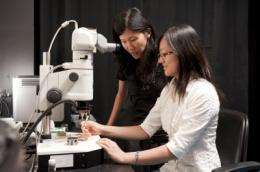New form of superhard carbon observed

An amorphous diamond – one that lacks the crystalline structure of diamond, but is every bit as hard – has been created by a Stanford-led team of researchers.
But what good is an amorphous diamond?
"Sometimes amorphous forms of a material can have advantages over crystalline forms," said Yu Lin, a Stanford graduate student involved in the research.
The biggest drawback with using diamond for purposes other than jewelry is that even though it is the hardest material known, its crystalline structure contains planes of weakness. Those planes are what allow diamond cutters to cleave all the facets that help give a diamond its dazzle – they are actually breaking the gem along weak planes, not cutting it.
"With diamond, the strength depends on the direction a lot. It's not a bad property, necessarily, but it is limiting," said Wendy Mao, the Stanford mineral physicist who led the research. "But if diamond is amorphous, it may have the same strength in all directions."
That uniform super-hardness, combined with the light weight that is characteristic of all forms of carbon – including diamond – could open up exciting areas of application, such as cutting tools and wear-resistant parts for all kinds of transportation.
Other researchers have tried to create diamond-like amorphous carbon, but have only been able to make extremely thin films that contain impurities such as hydrogen and do not have completely diamond-like atomic bonds. The amorphous diamond created by Mao and Lin can be made in thicker bulk forms, opening up more potential applications.
Lin is the lead author of a paper describing the research that will be published in Physical Review Letters. Mao, Lin's adviser, is a coauthor. Colleagues at the Carnegie Institution of Washington contributed to the research and are also coauthors.
The researchers created the new, super-hard form of carbon using a high-pressure device called a diamond anvil cell. They did a series of experiments with tiny spheres of glassy carbon, an amorphous form of carbon which they compressed between the two diamond anvils. The spheres were a few tens of micrometers (millionths of a meter) in diameter.
They slowly cranked up the pressure on the spheres. When the pressure exceeded 40 gigapascals – 400,000 times atmospheric pressure – the arrangement of the bonds between the carbon atoms in the glassy spheres had completely shifted to a form that endowed the spheres with diamond-like strength.
The researchers detected the shift in internal bonding by probing the spheres with X-rays.
They also did experiments in which a glassy sphere was simultaneously subjected to different pressures from different directions, to further assess the strength of the new form of carbon. While the diamonds in the anvil pressed in on the sides of the sphere with a pressure of 60 gigapascals – about 600,000 times atmospheric pressure – the pressure on the tip of the sphere reached 130 gigapascals.
"The amorphous diamond survived a pressure difference of 70 gigapascals – 700,000 atmospheres – which only diamond has been able to do," Mao said. "Nothing else can withstand that sort of stress difference."
Although the bonds between atoms in the glassy spheres were altered by the extreme pressure, the amorphous, or disordered, structure of the spheres was unchanged.
"The material doesn't get any more ordered as we compress it. It maintains its disorder," Mao said. The outer form of the original material was also retained – if the researchers started with a sphere, then even at the highest pressures, the sphere was still a sphere. The only change was in the type of bonds between the carbon atoms.
One characteristic of the new amorphous diamond is that it is not always hard or always soft. The hardness of the amorphous carbon is tunable; it is soft at low pressure, but the greater the pressure, the harder it gets. Once the pressure of the anvil was released, it returned to its original form as simple glassy carbon, with strength no greater than it had to begin with.
For the amorphous diamond to find widespread application, Mao said, someone will have to find a way to either make the material at low pressure or figure out how to preserve it once the super-hard form is created under high pressure.
Even though the amorphous diamond returned to plain old glassy carbon when the pressure was released, there are still potential applications. The material could be used as a gasket in high-pressure devices where having a gasket that hardens with pressure would be beneficial. Or it could be used in further high-pressure experiments.
"We use a diamond anvil cell to compress samples for high-pressure research, but because this amorphous diamond phase hardens with pressure, it could be a second stage anvil inside the diamond anvil," Lin said.
"Having another anvil in sequence would let us create even higher pressures at the very tip."
Since the focus of Mao's research group is to answer questions about the extreme environments in the deep Earth and other planetary interiors, a "double diamond" anvil could prove extremely useful. One can only speculate as to what exotic materials might be discovered with such an amped-up anvil.
Provided by Carnegie Institution




















